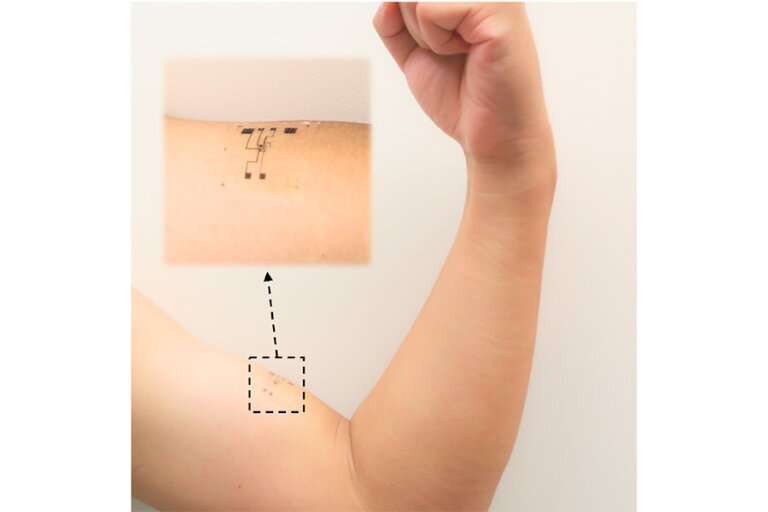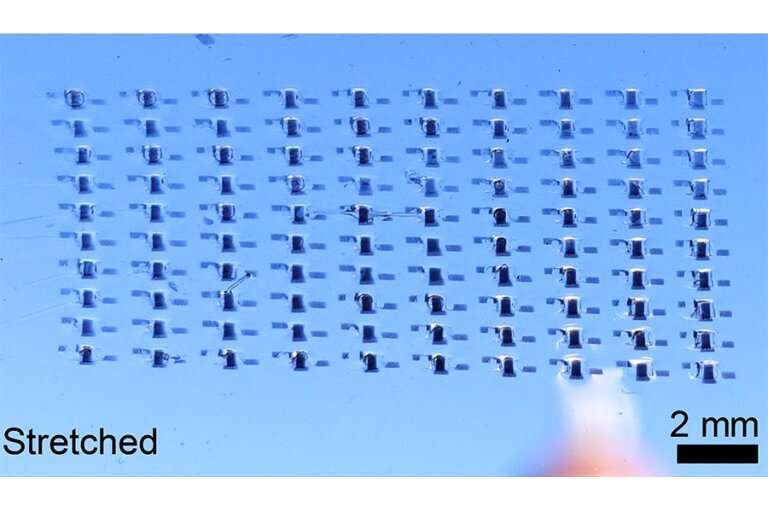A new PME design makes stretchable electronics more stable as they change shape, which could lead to next-generation sensors for healthcare applications. Credit: Photo courtesy of Wang Group
Our bodies send out hosts of signals—chemicals, electrical pulses, mechanical shifts—that can provide a wealth of information about our health.
But electronic sensors that can detect these signals are often made of brittle, inorganic material that prevents them from stretching and bending on our skin or within our bodies.
Recent technological advances have made stretchable sensors possible, but their changes in shape can affect the data produced, and many sensors cannot collect and process the body's faintest signals.
A new sensor design from the Pritzker School of Molecular Engineering (PME) at the University of Chicago helps solve that problem. By incorporating a patterned material that optimizes strain distribution among transistors, researchers have created stretchable electronics that are less compromised by deformation. They also created several circuit elements with the design, which could lead to even more types of stretchable electronics.
The results were published in the journal Nature Electronics. Asst. Prof. Sihong Wang, who led the research, is already testing his design as a diagnostic tool for amyotrophic lateral sclerosis, a nervous system disease that causes loss of muscle control.
"We want to develop new kinds of electronics that can integrate with the human body," he said. "This new design allows electronics to stretch without compromising data and could ultimately help lead us to an out-of-clinic approach for monitoring our health."
Designing a pattern of stiffness
To design the electronics, the researchers used a patterned strain-distribution concept. When creating the transistor, they used substrates made of elastomer, an elastic polymer. They varied the density of the elastomer layers, meaning some remained softer, while others were stiffer while still elastic. The stiffer layers—termed "elastiff" by the researchers—were used for the active electronic areas.
A closeup view of the design, which allows electronics to stretch without compromising data. Credit: Photo courtesy of Wang Group
The result was transistor arrays that had nearly the same electrical performance when they were stretched and bent as when they were undeformed. In fact, they had less than 5 percent performance variation when stretched with up to 100 percent strain.
They also used the concept to design and fabricate other circuit parts, including NOR gates, ring oscillators, and amplifiers. NOR gates are used in digital circuits, while ring oscillators are used in radio-frequency identification (RFID) technology. By making these parts successfully stretchable, the researchers could make even more complex electronics.
The stretchable amplifier they developed is among the first skin-like circuit that is capable of amplifying weak electrophysiological signals—down to a few millivolts. That's important for sensing the body's weakest signals, like those from muscles.
"Now we can not only collect signals, we can also process and amplify them right on the skin," Wang said. "That's a very important step for the future of electrophysiological sensing, when we can sense signals continuously."
A potential new diagnostic tool
Wang is already collaborating with a physician to test his design as a diagnostic tool for ALS. By measuring signals from muscles, the researchers hope to better diagnose the disease while gaining knowledge about how the disease affects the body.
They also hope to test their design in electronics that can be implanted within the body and create sensors for all kinds of bodily signals.
"With advancing designs, a lot of things that were previously impossible can now be done," Wang said. "We hope to not only help those in need, but also to take health monitoring out of the clinic, so patients can monitor their own signals in their everyday lives."
More information: Weichen Wang et al, Strain-insensitive intrinsically stretchable transistors and circuits, Nature Electronics (2021). DOI: 10.1038/s41928-020-00525-1
Journal information: Nature Electronics
Provided by University of Chicago

























